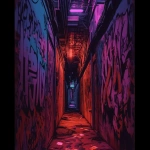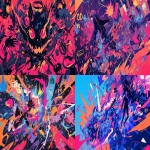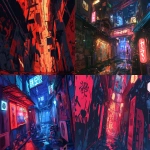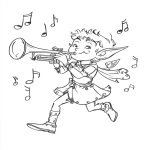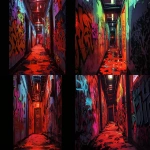Explore the Best AI Image Gallery

Beyond the Canvas: Blockchains Transformative Impact on the Creative Industry
The intersection of blockchain technology and the creative industry presents a fascinating landscape brimming with innovation and possibilities. While blockchain is often associated with finance and cryptocurrency, its decentralized and immutable nature has profound implications for how we create, share, and value art, music, and other forms of intellectual property. This blog post explores the transformative potential of blockchain in the creative sector, examining its diverse applications, addressing ethical considerations, and peering into future trends that are shaping this dynamic evolution.
Redefining Ownership and Authenticity
One of the most significant impacts of blockchain on the creative industry is its ability to establish clear ownership and provenance. Through NFTs (non-fungible tokens), artists can tokenize their digital creations, effectively representing them as unique assets on a secure and transparent ledger. This not only provides irrefutable proof of ownership but also allows for fractional ownership, democratizing access to valuable artworks.
Furthermore, blockchains immutability ensures that the authenticity and history of a creative work are permanently recorded. This combats counterfeiting and forgery, protecting artists from plagiarism and providing collectors with confidence in the legitimacy of their acquisitions.
Empowering Creators and Facilitating Direct Engagement
Blockchain technology empowers creators by enabling direct engagement with their audience and fostering a more equitable distribution of revenue. Platforms built on blockchain can facilitate micropayments, allowing artists to receive compensation for each use or view of their work. This eliminates intermediaries and ensures that creators retain a larger share of the profits generated from their creations.
Moreover, blockchain-based platforms can foster community building and fan engagement by enabling direct interaction between artists and their supporters. Artists can utilize these platforms to host exclusive content, offer rewards for participation, and cultivate a loyal following.
Expanding Creative Possibilities
Blockchains decentralized nature opens up exciting possibilities for collaborative creation and innovative art forms. Smart contracts, self-executing agreements coded on the blockchain, can automate royalty payments, define licensing terms, and facilitate complex collaborations between artists across geographical boundaries.
The fusion of blockchain with other emerging technologies such as augmented reality (AR) and virtual reality (VR) is creating immersive and interactive experiences that blur the lines between the physical and digital realms. Blockchain-based AR/VR platforms can enable artists to create interactive installations, host virtual exhibitions, and offer audiences unprecedented levels of engagement.
Ethical Considerations and Challenges
While blockchain offers immense potential for the creative industry, it is essential to address the ethical considerations and challenges that accompany this transformative technology:
- Data Privacy and Security: Blockchains immutability can raise concerns about data privacy if sensitive information is inadvertently recorded on the blockchain. Implementing robust security measures and anonymization techniques is crucial to protect user data.
- Accessibility and Inclusivity: Access to blockchain technology and its benefits should be equitable and inclusive. Efforts are needed to bridge the digital divide and ensure that all creators, regardless of their technical expertise or resources, can participate in this evolving landscape.
- Environmental Impact: Some blockchain platforms require significant energy consumption for transaction validation. Exploring more sustainable consensus mechanisms and promoting energy-efficient practices is essential to minimize the environmental footprint of blockchain technology.
Future Trends Shaping the Creative Landscape
The convergence of blockchain, AI, and other emerging technologies will continue to reshape the creative industry in profound ways:
- AI-Powered Creativity: Artificial intelligence will play an increasingly prominent role in creative processes, assisting artists with tasks such as generating ideas, composing music, and creating visual art.
- Decentralized Autonomous Organizations (DAOs):** DAOs, blockchain-based organizations governed by their members, have the potential to revolutionize the way creative projects are funded, managed, and executed.
- Immersive Experiences: The integration of blockchain with AR and VR will create immersive and interactive experiences that blur the lines between the physical and digital worlds, offering new avenues for artistic expression and audience engagement.
The future of creativity lies at the intersection of innovation and collaboration. Blockchain technology, with its potential to empower creators, redefine ownership, and foster transparency, is poised to revolutionize the creative landscape, ushering in an era of unprecedented possibilities for artistic expression and audience engagement.
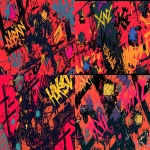
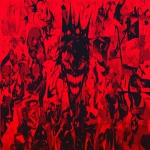



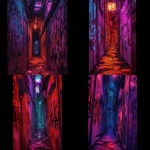

](https://images.ai-img.art/thumbnails/150/e407417f3921a9491278afc6484ec26f3ae374d4543e1a56898e8bcb1e41a0da.webp)
](https://images.ai-img.art/thumbnails/150/baf01e7f997f5bc030aa10831575d8b879a4a6755830df4bcd3dcc93346ef1dd.webp)

](https://images.ai-img.art/thumbnails/150/4dfe5499f7f4f9e5aa1613199c58710634f2cba5f57ac7e6717c1d56a9864e1a.webp)

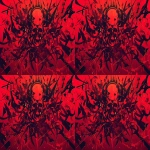


](https://images.ai-img.art/thumbnails/150/fd852e87169bf2f63982b31f7f16a8fa335d75d9536fd48c2b87c7d4b035fa7c.webp)
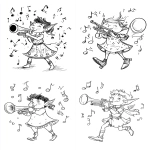




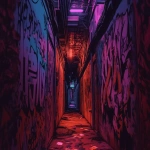

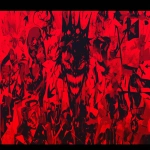



](https://images.ai-img.art/thumbnails/150/ed631f35091268316da1950d8f24949cf71c41220d75ddecc89232e1c28f3653.webp)



](https://images.ai-img.art/thumbnails/150/56d08b81b5991eca46f50c80b41db4e9ac06c775cbbf5138ea0734d93390316a.webp)


